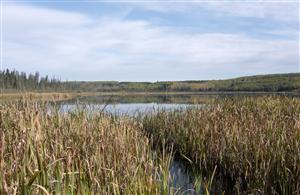Factors Affecting Water and Sediment Quality: Wetlands
Wetlands cover about 18% of Alberta, and are a significant feature of the boreal landscape. Within northern Alberta, different classes of wetlands include shallow open water, marshes, swamps, and peatlands (muskeg), which includes fens and bogs (Halsey 1999). These wetlands are distinguished by differences in water regime, vegetation type, and accumulation of organic matter.
In addition to providing habitat for numerous species, wetlands can enhance water and sediment quality in several ways, including (DUC 2008c, Perry and Vanderklein 2002):
- Regulating water balance. Wetlands can slow water flows and store water that may otherwise have led to flooding and erosion. Wetlands can also release water during dry periods, ensuring a certain level of flow, and can recharge groundwater supplies by allowing surface water to seep back into the ground.
- Trapping sediment and suspended particles. The slower-moving or still water found in wetlands allows solid particles—and any chemicals attached to these particles—to settle out of the water column. Vegetation found in wetlands helps to slow water flow and provide a physical barrier for trapping sediments.
- Supporting plants and microorganisms that can take up, use, or transform chemical compounds (e.g., nutrients) from the water column.
- Providing environmental conditions that allow for the transformation or adsorption of chemical compounds from the water column.









